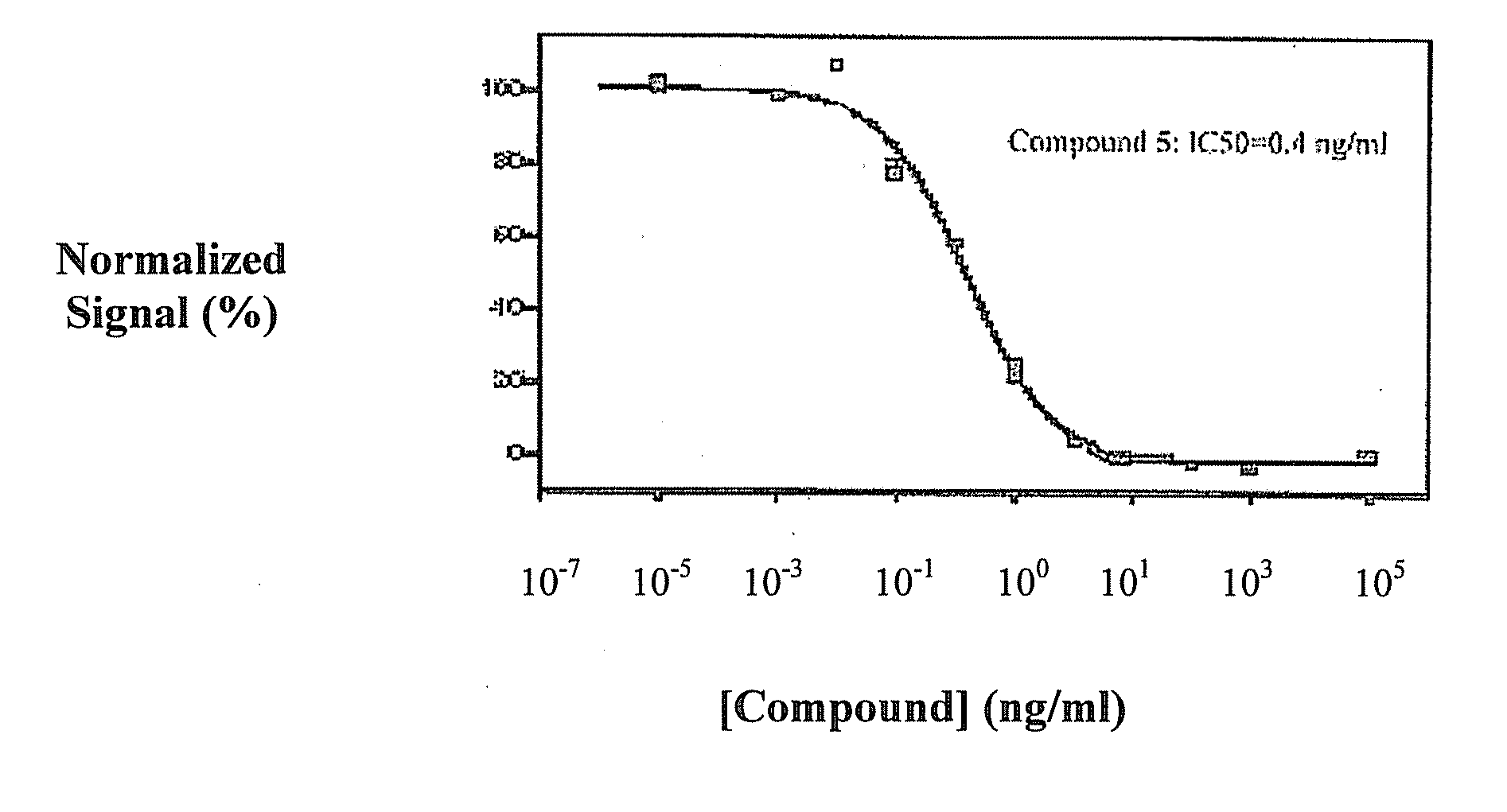Triazine derivatives and their therapeutical applications
a technology of triazine and derivatives, applied in the field of compounds, can solve the problems of poor ability of thymocyte development by mice without the lck gene, and achieve the effect of blocking the activity of other receptors and enzymatic activity
- Summary
- Abstract
- Description
- Claims
- Application Information
AI Technical Summary
Benefits of technology
Problems solved by technology
Method used
Image
Examples
example 1
[0191]
[0192]A mixture of ethyl β-ethoxyacrylate (26.50 g, 183 mmol) and 2 N sodium hydroxide (110 mL, 220 mmol) was refluxed for 2 h and cooled to 0° C. water was removed under vacc., and the yellow solids were triturated with toluene and evaporated to give the sodium β-ethoxyacrylate (25 g, 97%). The mixture of sodium β-thoxyacrylate (10.26 g, 74.29 mmol) and thionyl chloride (25 mL, 343 mmol) was refluxed for 2 h, and evaporated to give the β-ethoxyacryloyl chloride crude product, which was used without purification. To a cold stirring solution of 3-ethoxyacryloyl chloride in THF (100 mL) was added 2-chloro-6-methylaniline (6.2 mL, 50.35 mmol) and pyridine (9 ml, 111 mmol). The mixture was then warmed and stirred overnight at room temperature. Water was added at 0-10° C., extracted with EtOAc. The organic layer was washed with CuSO4 (3×50 mL) and the resulting solution was passed a pad of silica gel, concentrated under vacuum to give solids. The solids was diluted with toluene and...
example 2
[0193]
[0194]To a mixture of compound 1 (5.30 g, 22.11 mmol) in 1,4-dioxane (100 mL) and water (70 mL) was added NBS (4.40 g, 24.72 mmol) at −10 to 0° C. The slurry was warmed and stirred at 20-22° C. for 3 h. Thiourea (1.85 g, 26.16 mmol) was added and the mixture heated to 100° C. After 2 h, the resulting solution was cooled to 20-22° C. and conc. ammonium hydroxide (6 mL) was added dropwise. The resulting slurry was concentrated under vacuum to about half volume and cooled to 0-5° C. The solid was collected by vacuum filtration, washed with cold water, and dried to give 5.4 g (90% yield) of compound 2 as deep-yellow solids. 1H NMR (500 MHz, DMSO-d6) δ 2.19 (s, 3H), 7.09-7.29 (m, 2H, J=7.5), 7.29-7.43 (d, 1H, J=7.5), 7.61 (s, 2H), 7.85 (s, 1H), 9.63 (s, 1H); ESI-MS: calcd for (C11H10ClN3OS) 267, found 268 MH+).
example 3
[0195]
[0196]A solution of methylmagnesium bromide in ether (3M, 30 ml, 90 mmole) was added dropwise to a stirred solution of cyanuric chloride (3.91 g, 21.20 mmole) in anhydrous dichloromethane at −10° C. After the addition was complete, the reaction mixture was stirred at −5° C. for 4 h, after which time water was added dropwise at a rate such that the temperature of the reaction stayed below 10° C. After warming to room temperature, the reaction mixture was diluted with additional water and methylene chloride and passed through a pad of cilite. The organic layer was dried and evaporated to give 2,4-dichloro-6-methyl-1,3,5-triazine of 4 as yellow solids (3.02 g, 87%). 1H NMR (CDCl3) δ 2.70 (s, 3H).
PUM
| Property | Measurement | Unit |
|---|---|---|
| Pharmaceutically acceptable | aaaaa | aaaaa |
Abstract
Description
Claims
Application Information
 Login to View More
Login to View More - R&D
- Intellectual Property
- Life Sciences
- Materials
- Tech Scout
- Unparalleled Data Quality
- Higher Quality Content
- 60% Fewer Hallucinations
Browse by: Latest US Patents, China's latest patents, Technical Efficacy Thesaurus, Application Domain, Technology Topic, Popular Technical Reports.
© 2025 PatSnap. All rights reserved.Legal|Privacy policy|Modern Slavery Act Transparency Statement|Sitemap|About US| Contact US: help@patsnap.com



